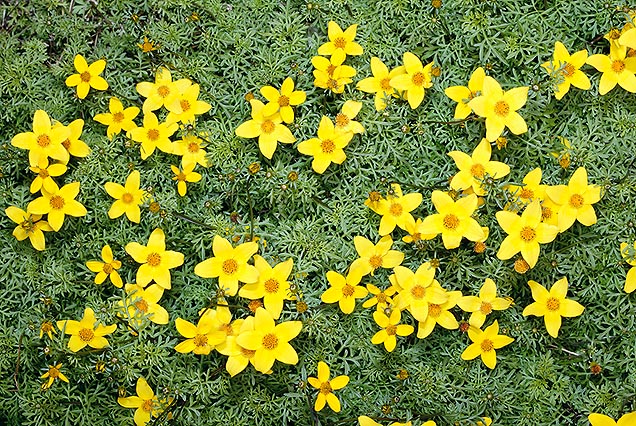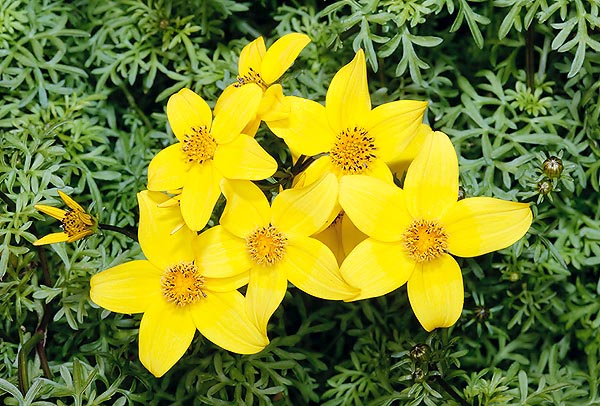Family : Asteraceae

Text © Pietro Puccio

English translation by Mario Beltramini

The perennial herbaceous Bidens ferulifolia is native to Arizona, Texas and Sonora © Giuseppe Mazza
The name of the genus comes from the Latin “bidens” = bidental (from “bis = twice, and “dens” = tooth), with reference to the two bristles present on the fruits of some plants of the belonging to the genus; the name of the species is the combination of the name “ferula” and the Latin word “folia” = leaf, due to the resemblance of the leaves to those of the genus Ferula (in particular those of Ferula communis).
Common names: Apache beggarticks, bur marigold, golden goddess, tickseed (English); biden à feuilles de ferule (French); agulha, bidens, chá-de-espanha, carrapicho-amarelo, erva-rapa, malpica, margarida-de-carrapicho, picão-amarelo, vara-de-mendigo (Portuguese); bidens, verbena amarilla (Spanish); Goldfieber, Goldkosmos, Goldmarie, Zweizahn (German).
The Bidens ferulifolia (Jacq.) Sweet (1830) is an evergreen herbaceous perennial plant, 15-50 cm tall and 30-90 cm broad, with much ramified stems, thin, procumbent and slightly pubescent on the nodes; it has opposite bipinnate leaves, 1,5-4,5 cm long and 1,5-2,5 cm broad, on an about 1,5 cm long petiole.
The inflorescences are a compound flower head, that is, formed by a main axis with ramifications, 2,5-5 cm long, ending in a flower head of 3-5 cm of diameter, the typical inflorescence of the Asteraceae. The flower head is formed by a host of sessile flowers, spirally inserted on a roundish base, the receptacle, surrounded by an involucre formed by a double series of linear or elliptic bracts, of green colour the 7-8 external ones, yellowish the 6-7 inner ones, 4-6 mm long and 1-2 mm broad.
The flowers of the outer ring, called ray florets, usually 5 (more in some cultivars), do have the ovate corolla with tridentate apex, 1-1,5 long and about 1 cm broad, formed by five united petals of yellow colour. The ray florets are sterile and have the function of attracting the attention of the pollinator like the petals of a single flower.

Fast growth, elegant leaves like ferns and copious blooming from spring to autumn © Giuseppe Mazza
It reproduces by seed, in winter in sheltered location (it germinates in 2-3 weeks at the temperature of 15-18 °C), or directly on the ground in spring, by apical cutting in spring or autumn and by division; it easily self-disseminates. It is the most cultivated species of the genus Bidens, appreciated for its fast growth, the slightly curved and subdivided foliage which recalls that of the ferns, and the abundant, bright and long-lasting blooming, from spring to late autumn.
For a better development, it needs full sun and is not particularly demanding about the soil, even if it prefers clayey, draining soils and regular fertilizations. It resists to the high temperatures, to the wind and to short drought periods. For this reason it may be also utilized in desert gardens, but it takes advantage from regular watering in the warmest periods; it well stands the pruning, also the drastic renewal ones, which are to be done by early spring or by the end of the blooming in late autumn.
It is utilized for hedges, as soil cover, rocky gardens, but the most common utilization is as pot plant for the decoration of balconies, terraces and patios; in particular, due to its drooping gait, is ideal for hanging pots.
Synonyms: Coreocarpus ferulaefolia Jacq. (1798); Coreopsis incurva Moench (1802); Coreopsis ferulacea Tilli (1804); Bidens procera D.Don (1822); Kerneria ferulaefolia (Jacq.) Cass. (1827); Bidens ferulifolia (Jacq.) DC. (1836); Coreopsis angustifolia Pav. ex DC. (1836); Bidens foeniculifolia DC. (1836); Coreopsis foeniculacea Moc. & Sessé ex DC. (1836); Coreopsis angustifulia Pav. ex D.Don (1882); Bidens ludens A.Gray (1886); Bidens carpodonta Sherff (1917).
→ To appreciate the biodiversity within the ASTERACEAE family please click here.
